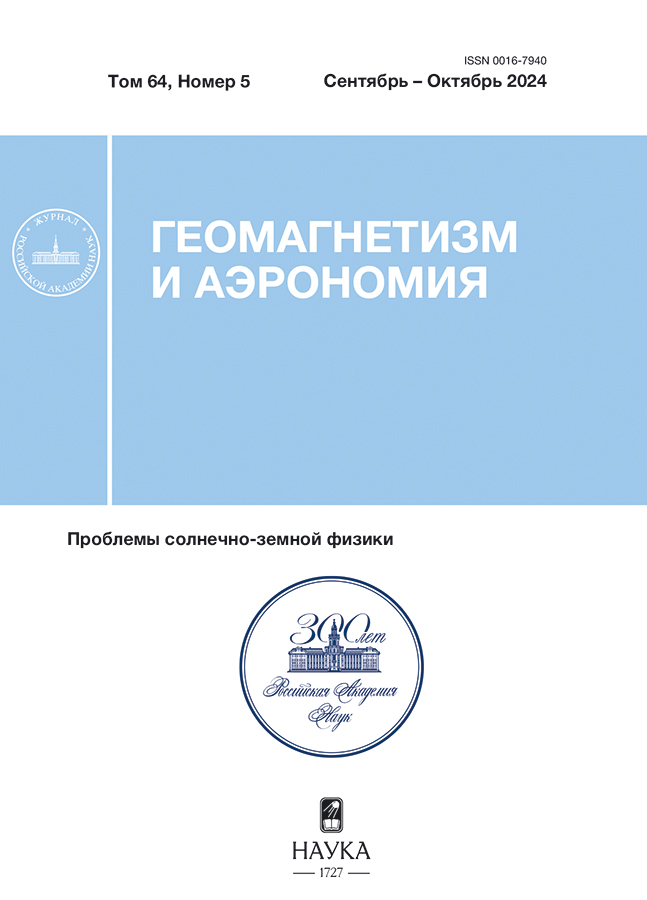Trends in Ionospheric Indices of Solar Activity
- Авторлар: Deminov M.G.1
-
Мекемелер:
- Pushkov Institute of Terrestrial Magnetism, Ionosphere, and Radio Wave Propagation, Russian Academy of Sciences (IZMIRAN)
- Шығарылым: Том 64, № 5 (2024)
- Беттер: 649-655
- Бөлім: Articles
- URL: https://kazanmedjournal.ru/0016-7940/article/view/686196
- DOI: https://doi.org/10.31857/S0016794024050052
- EDN: https://elibrary.ru/QQZLRQ
- ID: 686196
Дәйексөз келтіру
Аннотация
The first results of identifying trends in the annual average ionospheric indices ∆IG12 and ∆T12 are presented, which were obtained after excluding the dependence of these indices on solar activity indices from IG12 and T12. In this case, the solar activity indices are F10 and F30 – solar radio emission fluxes at 10.7 and 30 cm. It was found that for the interval 1957–2023 all analyzed linear trends are negative, i.e. the values of ∆IG12 and ∆T12 decrease with time, and these trends are significant. In absolute value, they are maximum for ∆IG12, taking into account the dependence of IG12 on F1012, and minimum for ∆T12, taking into account the dependence of T12 on F3012. Taking into account the nonlinearity of trends shows that, for example, after 2010 they intensified. Relationships are presented that allow, based on the data of trends in ionospheric indices (∆IG12 or ∆T12), to judge the nature of the ∆foF2 trend over a specific point. For this purpose, using the IRI model for foF2, a coefficient was obtained that gives the relationship between the trends of the ionospheric index and ∆foF2 over a given point. Based on a comparison with experimental data at mid-latitudes, it was found that trends in ionospheric indices make it possible to correctly determine the sign of the ∆foF2 trend and the general tendency for this trend to change, but the calculated trend value over a specific point may differ markedly from the experimental data.
Толық мәтін
Авторлар туралы
M. Deminov
Pushkov Institute of Terrestrial Magnetism, Ionosphere, and Radio Wave Propagation, Russian Academy of Sciences (IZMIRAN)
Хат алмасуға жауапты Автор.
Email: deminov@izmiran.ru
Ресей, Moscow, Troitsk
Әдебиет тізімі
- Данилов А.Д., Константинова А.В. Долговременные вариации параметров средней и верхней атмосферы и ионосферы (обзор) // Геомагнетизм и аэрономия. Т. 60. № 4. С. 411–435. 2020. https://doi.org/10.31857/S0016794020040045
- Деминов М.Г., Деминова Г.Ф. Эффективный индекс солнечной активности для медианы критической частоты F2-слоя // Геомагнетизм и аэрономия. Т. 60. № 5. С. 641–645. 2020. https://doi.org/10.31857/S0016794020050053
- Bilitza D. IRI the international standard for the ionosphere // Adv. Radio Sci. V. 16. P. 1–11. 2018. https://doi.org/10.5194/ars-16-1-2018
- Bruinsma S., Boniface C. The operational and research DTM-2020 thermosphere models // J. Space Weather Spac. V. 11. ID 47. 2021. https://doi.org/10.1051/swsc/2021032
- Caruana J. The IPS monthly T index / Proc. Solar-Terrestrial Prediction Workshop. Leura, Australia. October 16–20, 1989. V. 2. Ed. R.J. Thompson. Boulder, CO: Environmental Research Lab. P. 257–263. 1990.
- Chen Y., Liu L., Wan W. Does the F10.7 index correctly describe solar EUV flux during the deep solar minimum of 2007–2009? // J. Geophys. Res. – Space. V. 116. № 4. ID A04304. 2011. https://doi.org/10.1029/2010JA016301
- Danilov A.D., Berbeneva N.A. Statistical analysis of the critical frequency foF2 dependence on various solar activity indices // Adv. Space Res. V. 72. № 6. P. 2351–2361. 2023. https://doi.org/10.1016/j.asr.2023.05.012
- Danilov A.D., Konstantinova A.V. Variations in foF2 trends with season and local time // Geomagn. Aeronomy. V. 55. № 1. P. 51–58. 2015. https://doi.org/10.1134/S0016793215010041
- Danilov A.D., Konstantinova A.V. Trends in foF2 to 2022 and various solar activity indices // Adv. Space Res. V. 71. № 11. P. 4594–4603. 2023. https://doi.org/10.1016/j.asr.2023.01.028
- Jones W.B., Gallet R.M. The representation of diurnal and geographic variations of ionospheric data by numerical methods // Telecommun. J. V. 29. № 5. P. 129–149. 1962.
- Jones W.B., Gallet R.M. The representation of diurnal and geographic variations of ionospheric data by numerical methods. 2 //Telecommun. J. V. 32. № 1. P. 18–28. 1965.
- Laštovička J. Long-term changes in ionospheric climate in terms of foF2 // Atmosphere. V. 13. № 1. ID 110. 2022. https://doi.org/10.3390/atmos13010110
- Laštovička J., Burešova D. Relationships between foF2 and various solar activity proxies // Space Weather. V. 21. № 4. ID e2022SW003359. 2023. https://doi.org/10.1029/2022SW003359
- Laštovička J. Dependence of long-term trends in foF2 at middle latitudes on different solar activity proxies // Adv. Space Res. V. 73. № 1. P. 685–689. 2024. https://doi.org/10.1016/j.asr.2023.09.047
- Liu R., Smith P., King J. A new solar index which leads to improved foF2 predictions using the CCIR atlas // Telecommun. J. V. 50. № 8. P. 408–414. 1983.
Қосымша файлдар












